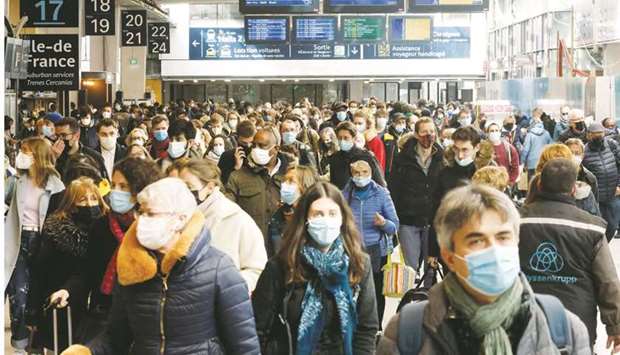Parisians packed inter-city trains leaving the capital yesterday, hours ahead of a new lockdown in the French capital imposed to combat a surge in coronavirus (Covid-19) infections.
The new restrictions, announced by Prime Minister Jean Castex late on Thursday, apply from midnight to around one-third of the country’s population, affecting Paris and several other regions in the north and south.
The government has insisted that the new month-long lockdown will be more limited than the two others imposed last year, with schools open and outdoor exercise allowed for an unlimited amount of time.
President Emmanuel Macron even insisted yesterday that the word “lockdown” (confinement in French) was not appropriate to describe the government’s strategy.
“What we want is to put a brake on the virus without shutting ourselves in. This is not being locked down,” he said at a meeting at the Elysee Palace. “Strictly speaking, the term lockdown is not right. What we are talking about are supplementary braking measures.”
However, the approach of the new curbs in Paris encouraged many to leave the notoriously-cramped city for areas without the measure, such as Brittany, the southwest Atlantic coast and Lyon in the southeast.
A spokesperson for national rail operator SNCF told AFP that trains for those destinations were now fully booked after having a 60-70% level of occupancy on previous Fridays.
Trains leaving Gare Montparnasse station in Paris – which serves destinations in Brittany and the southwest – were completely full after a rush of bookings late on Thursday.
Maiwenn, a 19-year old student clutching a giant suitcase, said she had decided to leave Paris to spend the rest of the university year with her family in Saint-Brieuc in Brittany.
“I’m going to stay there until the end of the term” that is scheduled for mid-April, she said, adding: “It’s been roughly a year that our courses have been on distance learning, so we’re starting to get used to it.”
The other regions that are affected by the new measures notably include the Hauts-de-France region of northeast France which covers the city of Lille, and the Alpes-Maritimes on the Mediterranean, as well as Seine-Maritime and the Eure in the north.
Health Minister Olivier Veran expressed hope that this regional lockdown would be the last, with the situation helped by the onset of spring and the vaccination campaign.
However, vaccinations have been sluggish so far in France, with just 5.6mn receiving a first dose, and the situation was not helped by the temporary suspension of the Astra-Zeneca jab this week.
Yesterday Prime Minister Jean Castex, 55, was given the AstraZeneca injection to build confidence in the vaccine, even as France’s health regulator said it should only be given to those aged over 55 after reports of blood clots.
As in previous lockdowns, a form written out or downloaded on a phone will be needed to justify why a person has left home in areas under the new restrictions.
Outdoor exercise is allowed up to 10km (six miles) from home for an unlimited amount of time but non-essential shops will have to close.
However bookshops – deemed as essential to public wellbeing – can stay open and government spokesman Gabriel Attal said hair salons could also continue to operate with reinforced sanitary protocols.
Finance Minister Bruno Le Maire said that the new measures would cost the treasury €1.2bn ($1.4bn) in additional compensation, relief and unemployment benefits.
According to a poll by Odoxa for Le Figaro and France Info just 56% of residents in the areas affected plan to abide by the new lockdown rules.

Parisians are seen at the Gare Montparnasse station, serving the west and southwest of France.
